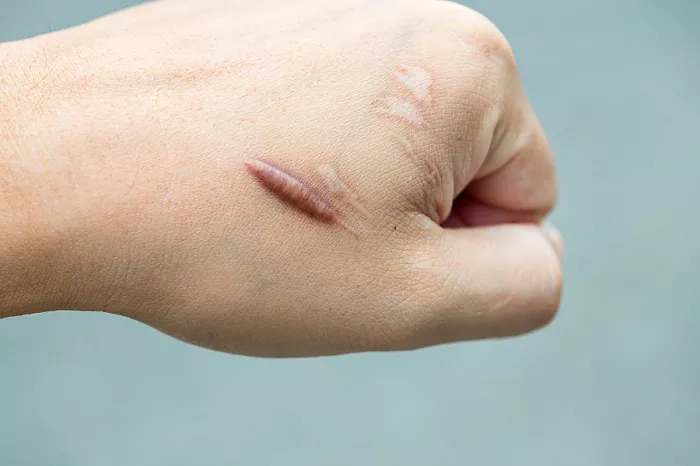Dermatitis herpetiformis (DH) is a rare, chronic skin condition closely linked to gluten intolerance, particularly in individuals with celiac disease. Although it primarily affects the skin, its underlying cause is an immune system response triggered by gluten, a protein found in wheat, barley, and rye. For those affected, the condition can be extremely uncomfortable and challenging to manage. However, with the right approach, symptoms can be controlled, and patients can lead relatively normal lives. This article will provide a comprehensive overview of dermatitis herpetiformis, its causes, symptoms, diagnosis, and treatment options.
Understanding Dermatitis Herpetiformis: A Skin Condition with Deep Roots
At first glance, dermatitis herpetiformis may resemble other common skin conditions such as eczema or psoriasis, but its roots run deeper than just skin irritation. The immune system of individuals with DH reacts abnormally to gluten, causing the body to produce antibodies that target the skin. These antibodies, along with other immune system factors, lead to the characteristic rash and blisters that are synonymous with the condition.
Most people with dermatitis herpetiformis also have celiac disease, though the reverse isn’t always true. While celiac disease primarily affects the digestive system, causing inflammation in the intestines when gluten is consumed, dermatitis herpetiformis presents externally on the skin. This makes DH a visible marker of an internal autoimmune reaction. However, unlike celiac disease, individuals with dermatitis herpetiformis may not necessarily experience gastrointestinal symptoms like bloating or diarrhea.
Symptoms of Dermatitis Herpetiformis: Recognizing the Signs
The symptoms of dermatitis herpetiformis can be severe and distressing, and they often appear suddenly. The most notable symptom is the appearance of clusters of small, itchy, fluid-filled blisters or bumps, typically on the elbows, knees, back, and buttocks. These rashes are usually very itchy, often leading patients to scratch them uncontrollably, which in turn can cause the skin to become raw and irritated.
The rash tends to appear in symmetrical patterns, with both sides of the body affected. The blisters are usually accompanied by redness and swelling, which may eventually burst and crust over, leaving behind scabs that can take time to heal. Over time, repeated flare-ups can lead to scarring, though scarring is not always a guaranteed outcome.
While the skin symptoms are most prominent, individuals with DH may also experience other less visible symptoms. These can include joint pain, particularly in the knees, elbows, and wrists, and an increased risk of other autoimmune diseases, such as thyroid disorders. Some individuals may also experience neurological symptoms, including headaches and tingling sensations.
How Is Dermatitis Herpetiformis Diagnosed?
Diagnosis of dermatitis herpetiformis can be challenging because its symptoms often overlap with other skin conditions. To properly diagnose DH, a healthcare provider will typically start by conducting a physical examination and reviewing the patient’s medical history, particularly regarding any symptoms of gluten intolerance or celiac disease.
A skin biopsy is often performed to confirm the diagnosis. During this procedure, a small sample of affected skin is taken and analyzed under a microscope for the presence of certain immune cells called granulocytes. The biopsy will typically show clusters of these cells beneath the surface of the skin, which is characteristic of dermatitis herpetiformis.
In some cases, a blood test may be conducted to check for elevated levels of antibodies against tissue transglutaminase (tTG), which are commonly present in individuals with celiac disease and dermatitis herpetiformis. If celiac disease is suspected but not yet diagnosed, an intestinal biopsy may also be recommended to look for signs of damage to the lining of the small intestine.
The Link Between Gluten and Dermatitis Herpetiformis
The underlying cause of dermatitis herpetiformis is an immune reaction to gluten. When someone with DH consumes gluten, their immune system mistakenly attacks the skin, leading to the characteristic rash. This autoimmune response is triggered by the presence of a specific protein in gluten, which the body recognizes as harmful. As a result, the immune system produces antibodies that target various tissues, including the skin.
It is important to note that gluten intolerance in DH does not solely affect the digestive system, as it does in classic celiac disease. Instead, the immune system’s response is focused on the skin, leading to the rash and other skin symptoms. This makes it crucial for individuals with DH to strictly avoid gluten in their diet, as even small amounts of gluten can trigger flare-ups.
Treatment Options for Dermatitis Herpetiformis: Managing the Condition
While there is no known cure for dermatitis herpetiformis, the condition can be effectively managed with the right treatment plan. The cornerstone of treatment is a strict gluten-free diet, which helps reduce the immune system’s response and prevent future flare-ups. Many individuals with DH find that their symptoms improve significantly once they eliminate gluten from their diet.
For individuals with more severe symptoms, medications may be necessary. The most commonly prescribed medication for DH is dapsone, an antibiotic that has anti-inflammatory properties. Dapsone can help reduce the intensity of flare-ups and control itching and inflammation. However, it is not a long-term solution and does not address the underlying gluten sensitivity. Patients may need to take dapsone for several months or even years, but it is typically used alongside dietary changes.
In some cases, other medications such as sulfapyridine or tetracycline may be prescribed if dapsone is not effective or causes side effects. These drugs work by targeting the immune response that causes the skin irritation and help reduce inflammation.
Living with Dermatitis Herpetiformis: Lifestyle Adjustments
Living with dermatitis herpetiformis requires ongoing attention to both diet and skin care. The gluten-free diet is a fundamental part of managing the condition and preventing flare-ups, but it can be challenging to adhere to. Individuals with DH must be vigilant about avoiding gluten-containing foods, which can sometimes be hidden in processed foods or even in cross-contaminated items. Fortunately, many people with DH find that once they strictly follow a gluten-free diet, their symptoms improve and may even disappear entirely.
Skin care is also an important aspect of managing dermatitis herpetiformis. Keeping the skin clean and moisturized can help reduce irritation and prevent scratching, which can lead to infection or scarring. Topical treatments, such as corticosteroid creams, may be recommended to reduce inflammation during flare-ups. In addition, avoiding harsh soaps and hot water can help prevent further skin damage.
Regular check-ups with a healthcare provider are essential to monitor the condition and ensure that the treatment plan is working effectively. It’s also important for individuals with DH to be aware of other potential complications, such as the increased risk of developing other autoimmune diseases or gastrointestinal issues associated with celiac disease.
Embracing a Gluten-Free Future
Dermatitis herpetiformis is a complex condition that requires a multifaceted approach to treatment. While the rash and blisters can be uncomfortable, the condition can be managed with a strict gluten-free diet and, in some cases, medication. By adhering to these treatment strategies, most individuals with DH can significantly improve their quality of life and minimize flare-ups.
It is essential for individuals with dermatitis herpetiformis to work closely with their healthcare provider to ensure proper diagnosis and treatment. With the right care and lifestyle adjustments, living with dermatitis herpetiformis can be manageable, allowing individuals to lead fulfilling lives free from the burden of skin discomfort and irritation.
Related Topics
































